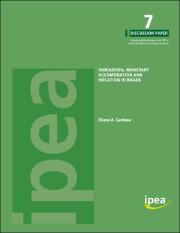Please use this identifier to cite or link to this item:
https://repositorio.ipea.gov.br/handle/11058/4811Full metadata record
| DC Field | Value | Language |
|---|---|---|
| dc.contributor.author | Cardoso, Eliana A. | - |
| dc.coverage.spatial | Brasil | pt_BR |
| dc.coverage.temporal | 1968-1979 | pt_BR |
| dc.date.accessioned | 2015-10-16T17:05:38Z | - |
| dc.date.available | 2015-10-16T17:05:38Z | - |
| dc.date.issued | 2015-01 | - |
| dc.identifier.uri | http://repositorio.ipea.gov.br/handle/11058/4811 | - |
| dc.description.abstract | O texto apresenta um modelo de indexação para taxas de câmbio e salário e desenvolve um modelo que permite estudar o comportamento da taxa de crescimento e da inflação em uma economia onde os salários são indexados com taxa inflacionária passada. | pt_BR |
| dc.language.iso | en-US | pt_BR |
| dc.publisher | Instituto de Pesquisa Econômica Aplicada (Ipea) | pt_BR |
| dc.title | Indexation, monetary accomodation and inflation in Brazil | pt_BR |
| dc.title.alternative | Discussion Paper 7 : Indexation, monetary accomodation and inflation in Brazil | pt_BR |
| dc.title.alternative | Indexação, acomodação monetária e inflação no Brasil | pt_BR |
| dc.type | Discussion Paper | pt_BR |
| dc.rights.holder | Instituto de Pesquisa Econômica Aplicada (Ipea) | pt_BR |
| dc.source.urlsource | http://www.ipea.gov.br | pt_BR |
| dc.location.country | BR | pt_BR |
| dc.description.physical | 22 p. : il. | pt_BR |
| dc.subject.vcipea | IPEA::Política Econômica. Política Social. Planejamento::Política Econômica | pt_BR |
| dc.subject.vcipea | IPEA::Condições Econômicas. Pesquisa Econômica. Sistemas Econômicos::Sistemas Econômicos | pt_BR |
| dc.rights.license | Reproduction of this text and the data it contains is allowed as long as the source is cited. Reproductions for commercial purposes are prohibited. | pt_BR |
| dc.subject.keyword | Indexação | pt_BR |
| dc.subject.keyword | Inflação | pt_BR |
| dc.subject.keyword | Salários | pt_BR |
| dc.subject.keyword | Taxa de câmbio | pt_BR |
| dc.subject.keyword | Taxa de crescimento | pt_BR |
| dc.relation.references | http://repositorio.ipea.gov.br/handle/11058/1082 | pt_BR |
| ipea.description.objective | Apresentar um modelo de indexação para taxas de câmbio e salário. | pt_BR |
| ipea.description.methodology | The model consists of a standard Keynesian model, closed by a Phillips curve and a wage indexation rule. Variables are stated in a growth rates. The author assumes to be demand determined, and demand to depend on the real money stock and on the expected inflation rate. Given the expected inflation rate, the expected real interest rate falls, stimulating demand. This is the Keynes-Hicks or liquidity effect. On the other hand, given the nominal interest rate, an increase in the expected inflation rate reduces the expected real interest rate and stimulates demand. This is know as the Mundell effect. | pt_BR |
| ipea.description.additionalinformation | Série monográfica: Discussion Paper ; 7 | pt_BR |
| ipea.description.additionalinformation | Possui referências bibliográficas e apêndice | pt_BR |
| ipea.description.additionalinformation | Originally published by Ipea in July 1981 as number 34 of the series Texto para Discussão | pt_BR |
| ipea.access.type | Acesso Aberto | pt_BR |
| ipea.rights.type | Licença Comum | pt_BR |
| ipea.englishdescription.abstract | This paper argues that between 1968 an 1979, due to indexation of exchange rates and wages, and because of monetary accommodation, the Brazilian inflation rate followed a random walk, while the real growth rate remained constant, except for uncorrelated shocks. Develops a model that permits to study the behavior of inflation and growth rates in an economy where wages are indexed to past inflation rates, purchasing power parity is guaranteed by a crawling peg, and where monetary authorities follow an accommodation rule. Concludes with the empirical evidence. | pt_BR |
| ipea.researchfields | N/A | pt_BR |
| ipea.classification | Administração Pública. Governo. Estado | pt_BR |
| ipea.classification | Economia. Desenvolvimento Econômico | pt_BR |
| ipea.classification | Sistema Monetário. Finanças. Bancos | pt_BR |
| Appears in Collections: | Economia. Desenvolvimento Econômico: Livros | |
Files in This Item:
| File | Description | Size | Format | |
|---|---|---|---|---|
| DiscussionPaper_7.pdf | 779.99 kB | Adobe PDF |  View/Open |
Items in DSpace are protected by copyright, with all rights reserved, unless otherwise indicated.

